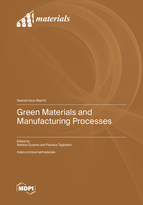Green Materials and Manufacturing Processes
A special issue of Materials (ISSN 1996-1944). This special issue belongs to the section "Green Materials".
Deadline for manuscript submissions: closed (10 June 2023) | Viewed by 28047
Special Issue Editors
Interests: manufacturing processes; laser technologies; coatings and surface finishing and functionalization; metal foams; additive manufacturing
Special Issues, Collections and Topics in MDPI journals
Interests: manufacturing materials; manufacturing technologies; machining; laser machining; 3D printing; DoE
Special Issues, Collections and Topics in MDPI journals
Special Issue Information
Dear Colleagues,
The green approach is no longer (and can no longer be) a goal of the future, but it is a real and practical necessity of the present. Recently, we have finally seen an acceleration in the development and application of green materials and manufacturing processes, and the importance of environmentally responsible materials or sustainable manufacturing processes has never been higher.
The aim of this Special Issue is to line up the most recently developed green materials and remarkable progress/developments in manufacturing processes, in order to take stock of new trends.
Scientific contributions can be focused on any alternative to traditional materials or processes that carry an environmental advantage, e.g., reduction of use of hazardous substances in manufacture, use of fewer natural resources, reduction of waste and pollution, recycle and reuse materials, and moderate emissions in processes.
Prof. Dr. Stefano Guarino
Dr. Flaviana Tagliaferri
Guest Editors
Manuscript Submission Information
Manuscripts should be submitted online at www.mdpi.com by registering and logging in to this website. Once you are registered, click here to go to the submission form. Manuscripts can be submitted until the deadline. All submissions that pass pre-check are peer-reviewed. Accepted papers will be published continuously in the journal (as soon as accepted) and will be listed together on the special issue website. Research articles, review articles as well as short communications are invited. For planned papers, a title and short abstract (about 100 words) can be sent to the Editorial Office for announcement on this website.
Submitted manuscripts should not have been published previously, nor be under consideration for publication elsewhere (except conference proceedings papers). All manuscripts are thoroughly refereed through a single-blind peer-review process. A guide for authors and other relevant information for submission of manuscripts is available on the Instructions for Authors page. Materials is an international peer-reviewed open access semimonthly journal published by MDPI.
Please visit the Instructions for Authors page before submitting a manuscript. The Article Processing Charge (APC) for publication in this open access journal is 2600 CHF (Swiss Francs). Submitted papers should be well formatted and use good English. Authors may use MDPI's English editing service prior to publication or during author revisions.
Keywords
- green materials
- green manufacturing processes
- waste reduction
- pollution reduction
- recycling
- sustainable manufacturing
- energy efficiency
- green and smart manufacturing








